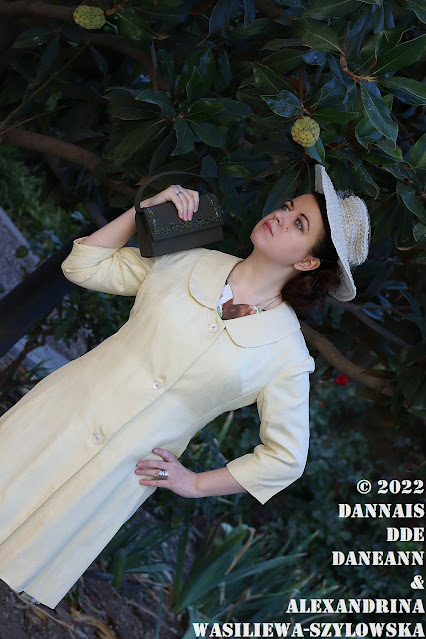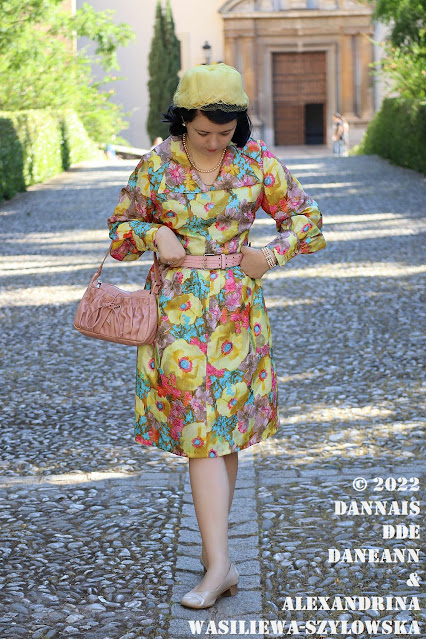Archive of 2022: Hot autumn outfit in style of 1945 with real vintage pencil dress & cartwheel hat by “Modas Flora”
As promised, I show the second version of wearing of the outfit with the same really vintage straight pencil dress and cotton belt with metal Art Nouveau style floral shaped buckle as in the previous outfit (“Archive of 2022: Very hot autumn outfit in style of 1945 with real vintage pencil dress & bowler hat").
This time I decided to pair the dress with a really vintage silk swing dustcoat/swagger and a really vintage Spanish cream raffia and straw wide brim picture cartwheel hat made in Andalusian city of Granada.
Even less is known about vintage Spanish brands of clothing and accessories than about any other European brands. Unfortunately, except their virtual world, modern Europeans and specifically Spaniards are of little interest about something real, and even the history of simple things that surround them or have ever surrounded, all the more so.
But the hat-making industry was once developed in Spain, and specifically in Granada. Now it is difficult to verify this, looking at modern Spaniards, who, neither under the scorching rays of the sun, nor under the gusts of gale-force icy winds, never even wear a knitted hat. And those who put it on head are not Spaniards. And this despite the fact that in the summer hatless Spaniards have to pay with sunstroke, and in winter with severe colds and infectious diseases, with which they generously reward others. In general, this is how things are now.
So, once upon a time, Granada was the center of the production of hats. By the middle of the 18th century, more than five hundred people worked in various hat guilds. And the 19th century was a real boom.
Therefore, it is not surprising that in the 1840s Pascual Madoz wrote his famous "Diccionario", in which he mentioned the developed hat industry in Granada, which produced "very high quality hats."
More than 2,000 people were working on the creation of those high-quality hats since the middle of the 19th century and in almost dozens of felt and hat workshops that were scattered throughout the city and especially in the historic Realejo district.
More than 2,000 people were working on the creation of those high-quality hats since the middle of the 19th century and in almost dozens of felt and hat workshops that were scattered throughout the city and especially in the historic Realejo district.
There were even brands that received gold and silver medals at the International Exhibition in Barcelona in 1888 - "José Entralla" and "Muñoz e Hijo". From the “Guía Comercial e Industrial” of 1895, we know that there were at least seven large hat factories in Granada, the largest of which was "Entralla", which employed about 500 workers and produced about 300,000 hats annually. And on Calle Zacatín, up to five hat shops functioned, including a certain nameless shop that boasted of selling five hundred hats a day!


The heyday of hat factories and shops in Granada came in the first third of the 20th century. Judging by the news and announcements in the local press, there were at least a dozen shops here.

The Spanish Civil War and World War II sowed confusion and poverty, but the custom of wearing head coverings still persisted. Indeed, at all times and in all parts of the world, not only the rich sought to look good. There was a concept of festive and Sunday clothes, when people dressed all the best in order to show themselves to others and themselves to look at other well-dressed people.
Yes, and the villagers, moving to the city or visiting it, always tried to dress decently and in a city way. Despite any wars and crisis, these were truly beautiful times when the streets, like flowers, were flooded with people in hats!
Until the 1960s, there were still very good times for production of hats around the world, as well as for Granada. The idea of "sinsombrerada" as a sign of modernity and protest against the existing government did not take root.
Authentic fashion lasted until the late sixties, when the protests of May 1968 swept across Europe. The young people, who had hitherto followed the custom of the elders, were the first to leave their heads uncovered. Granada's powerful felt and hat sector fell into a crisis that had disastrous consequences for the next two decades. Of the more than 2,000 factory workers and more than a dozen active shops in Granada during its heyday, only one remains in the city today, selling imported, non-local models.
However, it is not true to say that it was a complete global “sinsombrerada” after 1968. Even the Spaniards for some time wore, if not always felt hats, but at least straw and knitted hats. Moreover, they even knitted them themselves! This is evidenced by my small collection of Spanish vintage magazines, including knitting ones.
So until the 1990s, hats and caps still held on, with the last of their strength, but held on.
The full "sinsombrerada" has come since the 2010s.
The full "sinsombrerada" has come since the 2010s.
Someone, after reading this article, will rejoice and say: “That is well, that these stupid hats are gone!” But personally, I'm sad. It was sad to write about it and sad to see the world of “sinsombrerada” every day, when even modern Spanish monuments do not have their heads covered, although they depict some historical figures…
With the departure of hats, the fashion to be beautiful and elegant has also gone, the fashion to keep oneself in some special form, tends to some mysterious and beautiful look. After all, men in hats always look like gentlemen, and women look like ladies!
How beautiful and mysterious is the smile and eyes of the lady from under the veil or shadow created by the brim of the hat! Is there anything that can replace them? Not without reason they were sung in verses, prose and pictures!
Yes, and a hat, like any other similar headdress, is an opportunity to feel like a king or queen! I believe that it was a kind of gift from the Gods, a kind of “crown of creation”, which, unfortunately, people did not understand and lose.
But back to my outfit!
What can I say about the manufacturer of my hat - "Modas Flora", shown with this outfit? Almost nothing. It was only because the "Modas Flora" label had the address "15 Plaza del Carmen, Granada" where anything could be found.
This place is not some outskirts. This is a square in the center with the city hall building next door. Therefore, it was a luxury boutique/shop/workshop. But I was not able to find in which building "Modas Flora" was located. It is not always possible in Spain to find numbers near houses, and their numbering is somehow incomprehensible. It is possible that it was a building opposite the city hall, now demolished. However, I do not vouch for this, for these are only my assumptions.
Be that as it may, this brand is mentioned in the publication "Blanco y negro" of the publishing house "Prensa Española, S.A.", 1927 of the release. "Modas Flora" is mentioned as a separate enterprise. Whereas on another hat from the same manufacturer from my collection (black felt in an unusual shape), the label mentions "Modas Flora, Sucesora Enriqueta"!
That is, "Modas Flora" once at the very beginning of its existence was the heir to a certain "Enriqueta". And in the edition of "Blanco y negro" of 1927, "Modas Flora" is already listed without mentioning that this manufacturer is "the heir to Enriqueta". This means that another hat, which I will show you next time with a different outfit, is older than 1927!
Thus, that hat is younger than the late 1920s, but older than the 1930s!
I am wearing:
- Real vintage cream wild silk swing dustcoat/swagger with a big Peter Pan collar and 7/8 length sleeves, about 1940s
- Real vintage white with green and brown brush strokes flower print cotton little bit above knee length straight pencil dress with short sleeves and sweetheart neckline, about late 1940s or 1960s
- (not seen) Cream pure silk slip dress by "Hoss Intropia", 2010s-2020s
- Real vintage cream raffia and straw wide brim picture cartwheel hat with cotton crochet roses and silk voile décor by “Modas Flora” (15 Plaza del Carmen, Granada, Andalucía, Spain), about 1930s
- Real vintage green cotton belt with silver toned metal Art Nouveau style floral shaped buckle, made in Germany, about 1970s-1980s
- Real vintage olive green satin little purse with bead and ribbon roses embroidery, about 1980s
- Cream leather mid heel shoes, made in Spain, 2020s
From the previous version, I only have a dress and a belt in common, everything else is completely different. It is very exciting to "play" with accessories and watch how the outfit becomes different.














































Comments
Post a Comment